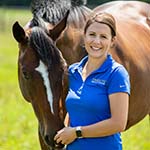A good feeding program promotes health and optimal performance of the horse day in and day out. The foundation of a feeding program is quality nutrition designed to meet the requirements of the individual horse.
Should be pretty simple, right? Purchase quality feed and your horse should look like a million bucks; however, sometimes things don’t go as well as we would hope and we need to take a step back and troubleshoot our feeding program.
Have You Chosen the Right Product(s) for Your Horse?
Feed companies have developed broad product lines for horses of varying stages of life and levels of work. The differences between these horse feeds for stages of life – pregnancy, lactation, growth, performance, maintenance or senior – can seem minimal; however, small changes in formulation are designed to meet the specific nutrient requirements for each of those stages of life.
For example, many senior feeds are designed to be fed at large quantities to replace the forage portion of the diet once horses are no longer able to process forage, most commonly due to declining dental health (worn/missing teeth). Consequently, many senior feeds are formulated to supply less nutrients per pound so that excess nutrients are not delivered when fed at large volumes. Feeding a senior feed to performance horses at low volumes may achieve adequate body condition, but fail to meet the non-energy requirements such as amino acids, minerals and vitamins needed to support top athletic performance and recovery from work. Similarly, a performance feed may meet the energy requirements of the lactating mare, but fail to provide important minerals in large enough quantity to support the demands of lactation.
Choose a feed that is appropriate for your horse's stage of life and level of work and feed at least the minimum recommended rate for your horse’s body weight. If you are unable to feed the minimum recommended rate without supplying too many calories for your horse’s needs, then it is simply not the right product for your horse. Feeding below the recommended rate will result in undersupplying non-energy nutrients that are key to supporting health and performance.
It can be very challenging to develop individualized feeding programs for large operations with horses in a wide variety of life stages and work levels without ending up with a feed room full of several different products. Complicated feeding programs make it difficult to complete feeding in a timely manner and also increase the likelihood that mistakes are made. It can be extremely helpful for diverse operations to have an on-farm assessment to develop a comprehensive program that utilizes a minimal number of products.
Are Other Factors Setting My Feeding Program Up for Failure?
We focus a lot on the bagged portion of the horse’s diet. While this is an important component, it is generally a small portion of the horse’s total diet (don't forget the forage!). Analyzing forage quality, whether hay or pasture, and the quantity the horse consumes should be high priority when a feeding program doesn't seem to be working well. Forage should be provided at a bare minimum of 1% of the horse’s body weight daily to support gastro-intestinal function, but a target intake of 1.5 to 2.5% of body weight in forage daily is recommended, with the exception of obese horses. Hay should be free from mold and debris and soft to the touch. In horse breeding operations or scenarios where horses are not performing as expected, a forage analysis is an extremely valuable tool.
Routine health management should also be considered in cases where a feeding program is not performing well. Particular attention should be paid to condition of teeth and parasite load. Guidance on a parasite prevention program specific to your region should be directed by your veterinarian. Effectiveness of a number of widely available dewormers has decreased over time due to over-use. Rotational programs are no longer the standard recommendation. Further, underlying health conditions that may contribute to gastro-intestinal upset and decrease feed efficiency should be ruled out. Feed competition for group-housed horses should be assessed, as well.
A number of different variables must be accounted for in developing a simple, but effective feeding program that is also economical. The list of variables to explore (covered in this article) when horses are not performing as expected on a feeding program are by no means definitively the culprit(s), but are good places to start. As always, Tribute Equine Nutrition is available for nutritional consultation.

